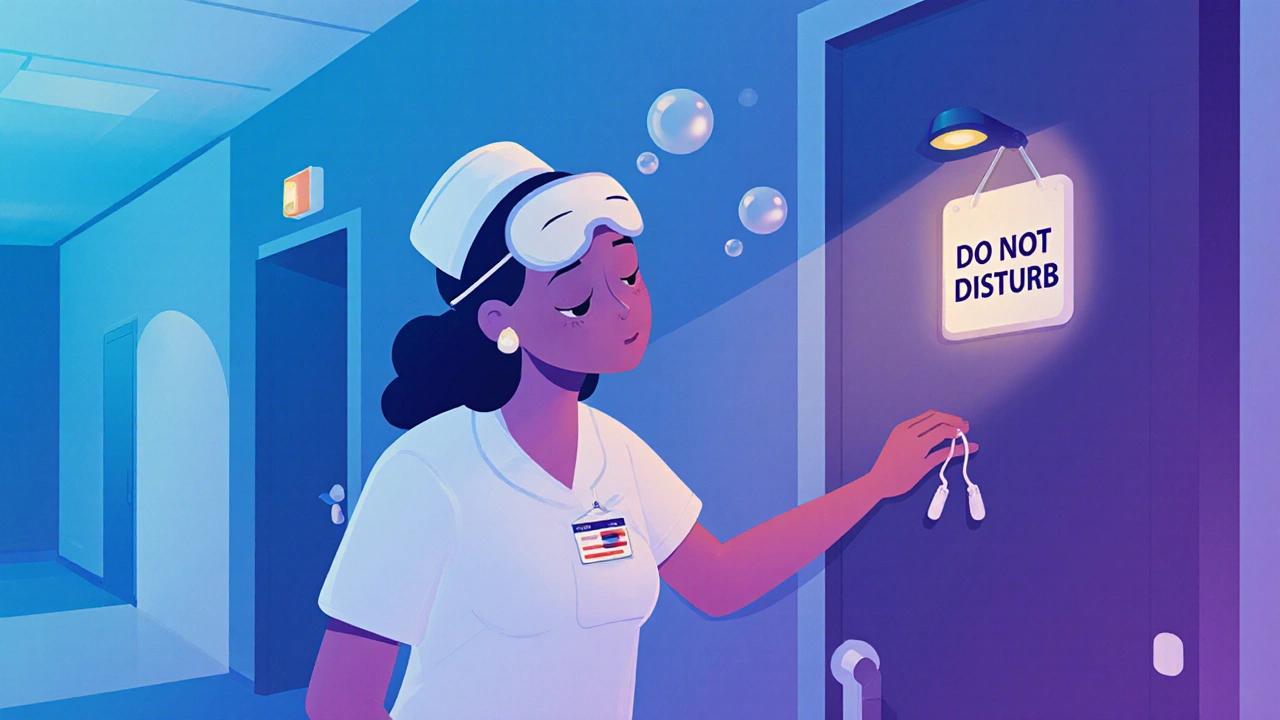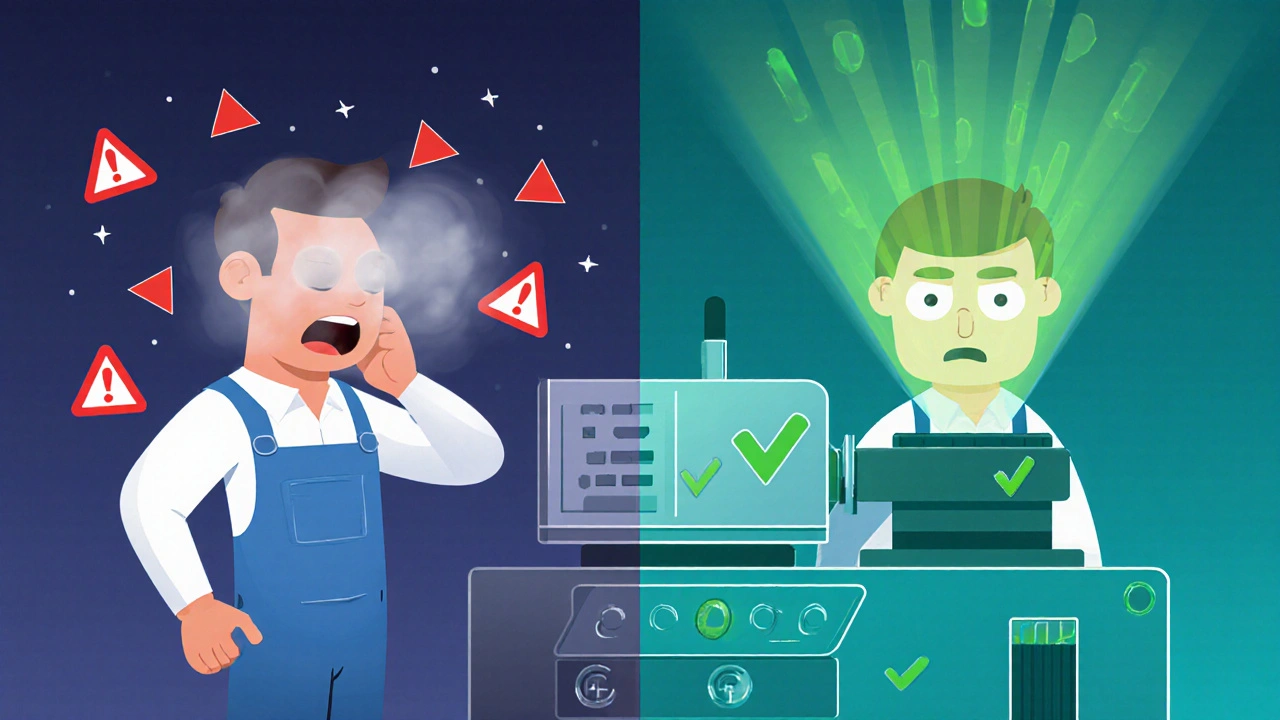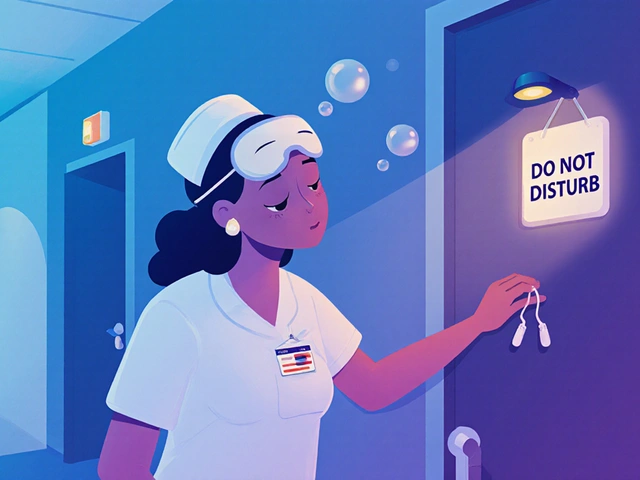Naps and Performance: Strategic Napping for Shift Workers

Why Shift Workers Need More Than Coffee
Working the night shift isn’t just inconvenient-it’s physically taxing. Your body isn’t designed to be awake when the sun’s down. Even if you’re used to it, your brain and body are fighting biology every hour. That’s why coffee, energy drinks, and sheer willpower don’t cut it. The real fix? A well-timed nap.
Studies show that shift workers who take strategic naps are 34% more alert and 54% less likely to make mistakes. That’s not a guess. That’s from NASA’s research on pilots, and it applies just as much to nurses, EMTs, and factory workers. A 26-minute nap can turn a foggy, error-prone shift into a sharp, safe one. And it’s not just about performance-it’s about survival. Shift workers have a 40% higher risk of heart disease, a 30% higher chance of breast cancer, and double the risk of ulcers. Strategic napping doesn’t fix all of that, but it cuts the immediate danger: drowsy driving, missed meds, and slow reactions that lead to accidents.
How Long Should a Nap Really Be?
Not all naps are created equal. A 90-minute nap might leave you refreshed-but it’ll also leave you groggy for 20 minutes after you wake up. That’s sleep inertia, and it’s dangerous when you’re about to operate machinery or give someone a shot.
The sweet spot? 20 to 30 minutes. That’s long enough to get into light sleep, reset your brain, and boost alertness-but short enough to avoid deep sleep. Deep sleep is great for recovery, but it’s the enemy of quick wake-ups. If you nap longer than 30 minutes, your body starts cycling into slow-wave sleep. Waking from that feels like being hit by a truck.
Real-world data backs this up. In CDC studies, nurses who napped 16 to 20 minutes during night shifts reported 7.3 out of 10 in helpfulness. Those who napped longer than 30 minutes didn’t feel better-they felt worse. And in hospital units where naps were capped at 25 minutes, medication errors dropped by 37% in six months. Timing matters. Duration matters. But length? That’s the key.
When to Nap: The Science of the Circadian Trough
It’s not enough to nap anytime you’re tired. You need to nap when your body is naturally crashing. That’s called the circadian trough. For most people on night shifts, that window is between 2:00 a.m. and 4:00 a.m.
Why then? Because your core body temperature drops, melatonin peaks, and your brain slows down-even if you’re forcing yourself to stay awake. That’s when sleepiness hits hardest. Napping during this window gives you the biggest bang for your buck. A 2024 study in Frontiers in Sleep Medicine found that naps taken between 1:00 a.m. and 3:00 a.m. improved alertness by 7.3 points on a 10-point scale. That’s the difference between recognizing a patient’s warning sign… and missing it.
Don’t nap at midnight. Don’t nap at 5 a.m. The science is clear: 2 to 4 a.m. is the gold zone. Even if you don’t feel sleepy yet, plan your nap for then. Your body will thank you.

Where to Nap: Environment Makes All the Difference
A nap in a quiet, dark room is like a full night’s sleep compared to a nap on a break room chair with fluorescent lights buzzing and coworkers chatting.
Research shows that a quiet, dark space cuts sleep onset time by 37%. That means you fall asleep faster, get better rest, and wake up sharper. In hospitals that installed dedicated nap rooms-soundproofed, with blackout curtains, temperature control, and comfy recliners-nap compliance jumped to 89%. In units that just used break rooms? Less than half the staff napped at all.
You don’t need a luxury suite. A corner with a recliner, an eye mask, earplugs, and a ‘Do Not Disturb’ sign can work. But if your workplace doesn’t provide even that, you’re being set up to fail. The Joint Commission says lack of nap opportunities contributed to 12% of nursing errors during night shifts. That’s not negligence-it’s a system failure.
Nap vs. Caffeine: What Actually Works?
Coffee is easy. You grab a cup, chug it, and feel a buzz. But that buzz fades fast-and it doesn’t fix your tired brain. A 200mg caffeine dose (about two cups of coffee) helps a little. But a 25-minute nap? It beats caffeine by 32% in sustained attention during the last two hours of a 12-hour shift.
And here’s the kicker: caffeine can mess with your next sleep. If you drink coffee at 3 a.m. to stay awake, you might not sleep at all when you get home. That means you’re building up sleep debt. A nap? It pays the debt.
Light therapy and sleep banking (sleeping extra before your shift) help too. But they take days to work. A nap? It works in 20 minutes. It’s the only tool that gives you instant, reliable results without changing your schedule.
Why Most Napping Programs Fail (And How to Fix Them)
Only 1 in 6 hospital units successfully run a nap program. Why? It’s not because workers don’t want to nap. It’s because management won’t let them.
Eighty-three percent of nurse managers say staffing shortages make napping impossible. Sixty-seven percent of night-shift workers feel guilty or judged for taking a nap-even when it’s allowed. That stigma kills the program before it starts.
Successful programs don’t leave napping to chance. They schedule it. Like a break. Like lunch. At 3 a.m., everyone stops. For 25 minutes. No exceptions. Managers cover the floor. Nurses nap. Then they come back sharper, safer, and more focused.
Training matters too. Workers need to know why 20 minutes is enough. They need to know how to wake up fast-splash cold water on your face, step into bright light, stretch. Those tiny habits reduce sleep inertia. And documentation? Track nap times, alertness scores, and errors. Show the numbers. When a unit proves errors dropped 37%, management stops resisting.

What’s Changing: New Rules, New Hope
The tide is turning. In 2022, California passed the Fatigue Risk Management Act, requiring employers to offer nap opportunities for 12-hour shift workers. OSHA’s 2024 draft guidelines now list strategic napping as a “best practice.” The American Nurses Association officially recommends it. And in Europe, the Working Time Directive has pushed healthcare adoption to 45%-nearly double the U.S. rate.
Technology is helping too. Wearable sleep trackers now pilot nap timing suggestions based on heart rate and movement. Early results show a 27% boost in nap effectiveness when workers nap when their body says it’s time-not when the clock says so.
And the economic case? Strong. For every dollar spent on nap rooms, training, and policy, hospitals get back $2.30 in reduced errors, fewer accidents, and lower turnover. That’s not a cost. That’s an investment.
What You Can Do Today
You don’t need permission to try this. If you work nights:
- Find a quiet, dark spot-even if it’s your car or a supply closet.
- Set an alarm for 20 to 25 minutes. No more.
- Time it between 2:00 a.m. and 4:00 a.m.
- Use earplugs and an eye mask.
- When you wake up, get up fast. Walk around. Open your eyes to bright light.
If your workplace doesn’t support napping, start small. Talk to your team. Track your own alertness before and after naps. Share the results. One nurse at a time, one unit at a time, change is possible.
It’s Not a Luxury. It’s a Safety Measure.
Strategic napping isn’t about being lazy. It’s about being smart. It’s about keeping yourself alive and your patients safe. You’re not skipping work-you’re protecting your brain so you can do your job right.
And if your employer won’t give you the space? That’s not your fault. But you can still take control of your sleep. Because your health doesn’t wait for policy changes. It waits for you to act.
How long should a nap be for shift workers?
For shift workers, the ideal nap is 20 to 30 minutes. This length gives you the benefits of light sleep without entering deep sleep, which causes sleep inertia-a groggy, disoriented feeling after waking. Naps longer than 30 minutes often leave you feeling worse than before.
What time is best to nap during a night shift?
The best time to nap is between 2:00 a.m. and 4:00 a.m., when your body’s natural circadian rhythm hits its lowest point in alertness. Napping during this window, known as the circadian trough, gives you the biggest boost in alertness and performance, according to CDC and NASA research.
Is napping better than caffeine for staying awake on night shifts?
Yes. A 25-minute nap improves sustained attention by 32% more than a 200mg caffeine dose during the final hours of a night shift. Caffeine gives a quick buzz but fades fast and can interfere with your next sleep. A nap actually restores brain function and reduces sleep pressure.
Can napping reduce errors at work?
Yes. In hospital units where nurses took 20-minute naps at 3 a.m., medication errors dropped by 37% over six months. The Joint Commission found that lack of napping opportunities contributed to 12% of nursing errors during night shifts. Strategic napping directly improves focus and decision-making.
Why don’t more workplaces allow naps?
The biggest barriers are staffing shortages and stigma. Many managers fear no one will cover the floor, and workers often feel guilty for napping-even when it’s allowed. Successful programs solve this by scheduling naps like breaks, training staff on their benefits, and creating quiet, dedicated nap spaces.
Do I need special equipment to nap at work?
No, but it helps. A comfortable recliner, eye mask, and earplugs make a big difference. If you’re napping in a car or break room, a blanket and noise-canceling headphones can work. The key is blocking light and sound to fall asleep faster and get deeper rest in a short time.
Can napping help with long-term health risks from shift work?
Strategic napping doesn’t eliminate long-term risks like heart disease or cancer linked to shift work, but it reduces acute fatigue that worsens those conditions. Lower stress hormones (like cortisol), better sleep quality, and fewer accidents mean your body has more resilience. It’s not a cure, but it’s a vital protective tool.


Nicole M
I've been napping 20 minutes at 3 a.m. on nights at the ER. No more coffee crashes. Just woke up sharp, did my med checks clean, and didn't miss a single code. This isn't laziness. It's survival.
Arpita Shukla
Actually, the optimal nap duration varies by individual circadian rhythm. NASA's 26-minute standard is based on pilots with monotonous tasks. Nurses have variable cognitive loads. A 20-30 minute window is a heuristic, not a law. Some need 15, others 45. It's not one-size-fits-all.
Benjamin Stöffler
The circadian trough isn't just a biological phenomenon-it's a metaphysical surrender to entropy. We fight the dark, we fight the clock, we fight our own biology... and yet, in that 2:00 a.m. silence, we allow ourselves a surrender-brief, sacred, and utterly necessary. A nap isn't rest. It's a rebellion against the machine.
Mark Rutkowski
There's something deeply human about this. We're told to push through, to grind, to be tough-but the body knows better. A 20-minute nap is like hitting pause on a broken record. It doesn't fix the system, but it lets you breathe long enough to remember why you're still here. You're not weak for napping. You're wise.
Ryan Everhart
So we're supposed to nap because the system won't fix itself? Cool. Meanwhile my manager says 'we're short staffed' like it's a badge of honor. I nap in the supply closet. No one notices. No one cares. Just me, my eye mask, and the smell of disinfectant. It's not a program. It's a patch.
David Barry
Let's be real. 37% fewer errors? That’s a cherry-picked stat. Most studies don’t control for shift length, workload, or baseline sleep debt. Also, nap compliance in ‘successful’ units? Probably inflated by peer pressure. People nap because they’re told to, not because it works. The ROI is speculative.
Alyssa Lopez
This is why america is falling behind. We dont have time for naps. We got to be productive. In china they work 14 hours straight. No naps. No excuses. Just grit. You want to be a real nurse? You dont nap. You push through. Caffeine is for weaklings.
Alex Ramos
I used to think napping was for slackers. Then I started tracking my alertness with my Fitbit. After a 22-min nap at 3 a.m., my HRV spiked, my reaction time dropped from 850ms to 420ms. I’m not just saying this-I’ve got the graphs. If you’re on nights, try it. You’ll thank me later. 😊
edgar popa
20 mins. 3am. eye mask. done. i dont need a study to tell me my brain feels better. just do it.
Eve Miller
The author ignores the fact that napping during work hours violates OSHA’s duty to provide a safe workplace by encouraging unmonitored, unsupervised sleep in potentially hazardous environments. This is irresponsible. If you need rest, take a scheduled break-not an unauthorized siesta.
Chrisna Bronkhorst
Naps? Please. In my hospital, if you sleep on the job, you get written up. The only thing that matters is output. If you’re tired, quit. There’s a line of 20 people outside who’ll take your shift. Sleep is a privilege for people with 40-hour weeks.
Amie Wilde
I nap in my car. Sometimes I fall asleep before I even get the mask on. Doesn't matter. 15 minutes. 3 a.m. I wake up, splash water on my face, and go back in. My patients notice. My team notices. My boss? Still doesn't get it. But I'm still here. And I'm still sharp.
Gary Hattis
In South Africa, we call this 'ubuntu sleep'-resting so the whole community can thrive. I work nights in a rural ER. No nap room. No quiet. But I’ve got a folding chair, a blanket, and a cousin who watches the front desk while I close my eyes. It’s not policy. It’s culture. And it saves lives.
Benjamin Stöffler
Ah, but here’s the irony: the very system that demands we sacrifice our biology for productivity is the same one that refuses to fund the infrastructure to preserve it. We are not machines. We are not batteries. We are flesh-and-blood organisms trapped in a spreadsheet. And yet, we nap-because even the most rigid system cannot fully extinguish the human need to rest.